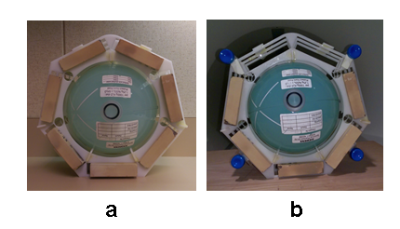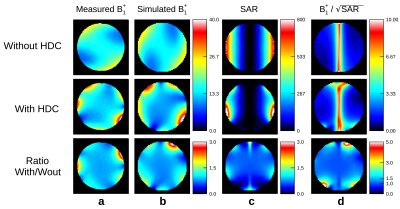4301
Possibilities for local SAR Reduction with uHDC Material & 2 Ch pTX1Radiology, Penn State College of Medicine, Hershey, PA, United States, 2Penn State Harrisburg, Harrisburg, PA, United States, 3Neurosurgery, Penn State College of Medicine, Hershey, PA, United States
Synopsis
Variation of the RF transmit field polarization in conjunction with the application of a uHDC monolithic block was explored within the context of reducing local SAR, through RF field simulations and B1+ mapping. A linear polarization in conjunction with a discrete uHDC block was found to substantially reshape the null band in the electric field, which opens new possibilities for local SAR reduction.
Purpose
Dielectric materials offer beneficial effects to RF coil efficiency, both in the transmit and receive case. Some prior work has characterized benefits to global transmit efficiency with quadrature drive [1,2], and 2 channel pTX [3,4,5]. With quadrature drive, local SAR reduction within the vicinity of the HDC material has been observed in 3T simulations of the head [6]. The goal of this work is to explore the effect of variation of the transmit polarization in several scenarios, possible with a 2 Ch pTX body coil, on the local SAR.Methods
The interaction of the transmit field polarization and uHDC material was examined in two scenarios. 1a) A spherical phantom (d = 168 mm) filled with agar (σ = 1.9 S/m), surrounded by a plastic frame containing 5 or 7 uHDC blocks (105x85x20 mm, Er = 850). The experimental setup is depicted in Fig. 1. Experimental B1+ mapping was performed with the Bloch-Siegert technique in both quadrature and linear mode, for the case with 7 blocks (Fig 1a) and with no blocks present. Temperature mapping was performed with an elliptical polarization and the PRFS technique, for the case with 5 blocks only (Fig. 1b). A heating period of 2 minutes was utilized. Both experiments were performed on a Siemens 3T PrismaFit. Transmission & reception utilized the 2 Ch pTX body coil. All experiments were calibrated such that the central axial slice achieved a mean value of 15.4 uT, including the heating experiments. In addition, a corresponding version of the setup in Fig 1. was built in xFDTD 7.0 for field simulation. The B & E distributions were simulated on a model of the 2 Ch pTX body coil. The fields were subsequently combined in Matlab to achieve quadrature or linear polarization. 2) The Ella body model (Virtual Family, IT'IS Foundation, Switzerland) was simulated within a model of the 2 Ch pTX body coil, for the case without uHDC material and with either a uHDC block or ring (Er = 850) surrounding the head. The E fields were combined to achieve a near-linear polarization.Results & Discussion
All SAR values are given in A.U. Figure 2 displays experimental
and simulated results for B1+, SAR, and B1+
/ sqrt(SAR) acquired with quadrature polarization and 7 blocks within the
frame. There is good agreement between measured and simulated B1+
maps. A series of peaks in the B1+ maps are localized
near the center of each block. In the
corresponding SAR maps, there is a pattern of dips and peaks at the location of
each B1+ peak. The inclusion of uHDC material leads to a
reshaping of the circumpolar current distribution and SAR in the sphere, such
that it is shifted away from the center of the uHDC block. Furthermore, the
local transmit efficiency (Fig. 2d) is enhanced greatly at the location of the
SAR dip and remains unaffected elsewhere. Figure 3 displays the
corresponding results for linear polarization and 7 blocks in the frame. A
slight rotation between measured and simulated B1+ maps
is due to a 22.5 degree offset in the simulated coil model. An interesting
behavior was observed where the null band in the SAR pattern expands at the
base of the sphere (Fig. 3c), to coincide with the uHDC blocks at the base of
the phantom. Figure 4 displays measured and simulated B1+
and temperature maps from the heating experiment. The B1+
maps show good agreement between experiment and simulation. The temperature
maps, while not corresponding in terms of scale, do agree overall in terms of
the basic pattern. The temperature map calculation utilized 4 oil phantoms to
obtain a frequency drift map, and there is most likely some error in the drift
map. Figure 5 displays the results of the human simulation with linear
polarization. All cases have been scaled such that a mean of 11.7426 uT is
obtained on a central axial slice in the brain. The placement of a uHDC block
beneath the head leads to a reshaping of the SAR distribution. The use of a
ring leads to a lower SAR distribution compared to baseline, but the overall
pattern is similar.Conclusion
The use of uHDC material can lead to reduced global and local SAR with the typical quadrature polarization. Application of a linearly polarized field in conjunction with discrete uHDC material can lead to a substantial reshaping of the null band in the SAR pattern. This behavior could potentially be exploited for imaging with device implants such as a deep brain stimulator, though this would require the development of an optimized uHDC configuration specific to the application at hand.Acknowledgements
This work was supported by grants from the NIH and Penn State Hershey Neuroscience Institute.References
[1] Yang, Q. X, et al. Radiofrequency field enhancement with high dielectric constant (HDC) pads in a receive array coil at 3.0T. J Magn Reson Imaging, 2013 38(2): 435-440 [
2] Rupprecht et al. Improvements of transmit efficiency and receive sensitivity with ultrahigh dielectric constant (uHDC) ceramics at 1.5 T and 3 T. Magn Reson Med 2017
[3] Winkler et al. Practical methods for improving B1+ homogeneity in 3 Tesla breast imaging. J Magn Reson Imaging, 2015 41(4): 992-999
[4] Koolstra et al. Improved image quality and reduced power deposition in the spine at 3 T using extremely high permittivity materials. Magn Reson Med 2017.
[5] Brink et al. The effect of high-permittivity pads on specific absorption rate in radiofrequency-shimmed dual-transmit cardiovascular magnetic resonance at 3T. J Cardiovasc Magn Reson 17(1)
[6] Sica et al. Ultra High Dielectric Constant (uHDC) Head Insert at 3T for Dramatic Reduction of SAR and B1+ inhomogeneity. Proceedings of the 22nd Annual Meeting of the ISMRM, p405.
Figures




